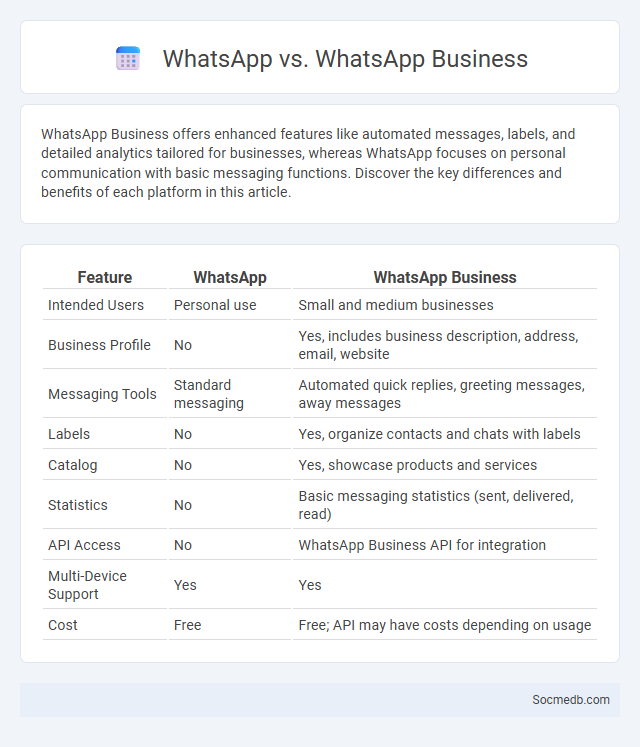
Photo illustration: WhatsApp vs WhatsApp Business
WhatsApp Business offers enhanced features like automated messages, labels, and detailed analytics tailored for businesses, whereas WhatsApp focuses on personal communication with basic messaging functions. Discover the key differences and benefits of each platform in this article.
Table of Comparison
| Feature | WhatsApp Business | |
|---|---|---|
| Intended Users | Personal use | Small and medium businesses |
| Business Profile | No | Yes, includes business description, address, email, website |
| Messaging Tools | Standard messaging | Automated quick replies, greeting messages, away messages |
| Labels | No | Yes, organize contacts and chats with labels |
| Catalog | No | Yes, showcase products and services |
| Statistics | No | Basic messaging statistics (sent, delivered, read) |
| API Access | No | WhatsApp Business API for integration |
| Multi-Device Support | Yes | Yes |
| Cost | Free | Free; API may have costs depending on usage |
Introduction to WhatsApp, WhatsApp Business, and Linked Devices
WhatsApp is a widely used messaging app that offers instant communication through text, voice, and video calls, supporting over 2 billion active users globally. WhatsApp Business enhances this platform by providing tools tailored for businesses, including automated messages, catalog displays, and customer support features to improve user engagement. Linked Devices enable users to access their WhatsApp accounts simultaneously on multiple devices without requiring the primary phone to be online, ensuring seamless connectivity across smartphones, desktops, and web browsers.
Core Features Comparison: WhatsApp vs WhatsApp Business
WhatsApp offers core features such as encrypted messaging, voice and video calls, group chats, and status updates, designed primarily for personal communication. WhatsApp Business enhances these capabilities with tools like automated greeting messages, quick replies, product catalogs, and labels for customer organization, tailored for small to medium enterprises. Both apps support end-to-end encryption, but WhatsApp Business integrates API access for larger-scale customer management and marketing automation.
User Interface Differences
Social media platforms vary significantly in user interface design, influencing your navigation and interaction efficiency. Instagram emphasizes visual storytelling with a grid layout and swipe gestures, while Twitter prioritizes real-time updates with a timeline feed and threaded conversations. Understanding these differences ensures you can maximize engagement and usability across various social media channels.
Business Tools and Automation Features
Social media platforms offer a variety of business tools and automation features designed to streamline marketing efforts and improve customer engagement. Features like scheduled posting, analytics dashboards, and automated responses enable businesses to efficiently manage their online presence and make data-driven decisions. Integration with CRM systems and AI-powered chatbots further enhances lead generation and customer support capabilities.
Messaging and Communication Capabilities
Social media platforms provide robust messaging and communication capabilities that enable real-time interaction and instant sharing of multimedia content. Features such as direct messaging, group chats, voice and video calls, and integrated chatbots enhance user engagement and streamline personalized communication. Advanced encryption protocols and customizable privacy settings ensure secure and private exchanges across popular networks like WhatsApp, Facebook Messenger, and Instagram Direct.
Multi-Device Usage with Linked Devices
Multi-device usage enhances your social media experience by allowing seamless access across smartphones, tablets, and computers. Linked devices enable synchronized notifications, messages, and media sharing, ensuring you stay connected without interruption. This integrated approach optimizes engagement and convenience, adapting to your lifestyle effortlessly.
Privacy and Security: Side-by-Side Analysis
Social media platforms implement various privacy settings and encryption methods to protect user data, yet vulnerabilities persist due to frequent policy changes and third-party integrations. User awareness of privacy controls significantly impacts the effectiveness of security measures, highlighting the need for ongoing education and transparent data handling practices. Comparative studies reveal that end-to-end encryption and minimal data retention policies consistently enhance user privacy and security across diverse social networks.
Ideal User Profiles for Each Platform
Understanding ideal user profiles for each social media platform enhances Your content strategy by targeting the right audience. Instagram appeals to younger demographics who prefer visual storytelling, while LinkedIn caters to professionals seeking networking and industry insights. Facebook attracts a broad age range with interests in community engagement and personal connections, making platform-specific content crucial for maximized engagement.
Pricing and Availability
Social media platforms typically offer free access with premium subscription options ranging from $5 to $50 monthly, providing enhanced features like ad-free experiences, advanced analytics, and exclusive content. Availability spans desktop and mobile applications across iOS, Android, and web browsers, ensuring global reach with localized versions for different languages. Business and enterprise solutions often include tiered pricing models based on audience size, ad spend, and additional marketing tools.
Choosing the Right Solution for Your Needs
Selecting the right social media platform depends on your target audience, content type, and business goals. Analyzing user demographics and engagement metrics on platforms like Instagram, LinkedIn, or TikTok ensures alignment with your marketing strategy. Choosing the optimal solution maximizes reach and boosts your brand's online presence effectively.
 socmedb.com
socmedb.com